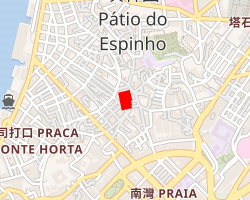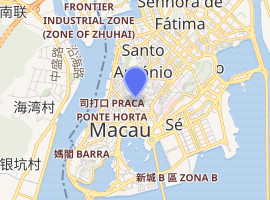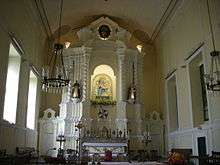Church of Saint Dominic, Macau
Saint Dominic's Church (Chinese: 板樟堂; Portuguese: Igreja de São Domingos) is a late 16th-century Baroque-style church that serves within the Cathedral Parish of the Roman Catholic Diocese of Macau. It is located in the peninsular part of the city at the Largo de São Domingos, situated near the Leal Senado Building.
| Saint Dominic's Church | |
|---|---|
| |

| |

| |
| Location | Largo de São Domingos, Sé, Macau, China |
| Denomination | Roman Catholic |
| History | |
| Status | Parish church |
| Architecture | |
| Functional status | Active |
| Style | Baroque |
| Completed | 1587 |
| Administration | |
| Parish | Cathedral Parish |
| Diocese | Roman Catholic Diocese of Macau |
| Clergy | |
| Bishop(s) | Stephen Lee Bun-sang |

The construction of the church was finished in 1587 and was overseen by three Spanish Dominican priests. Due to renovations and reconstruction, the current structure dates back to the early 17th century. The church is listed as one of the 29 sites that form the Historic Centre of Macau, a UNESCO World Heritage Site.[1]
History
The church was established in 1587 by three Spanish Dominican priests[2] who arrived from Acapulco, Mexico.[3] It was the scene of violence in 1644, when a Spanish officer—loyal to the King of Spain and opposing the colony's determination to stay allegiant with Portugal after the dissolution of the Iberian Union—entered the church in order to seek refuge from an angry mob. He was promptly murdered at the foot of the altar while mass was being celebrated.[2][3] Sixty-three years later, in 1707, the Dominicans supported the Pope's stance with regards to the Chinese Rites controversy. This was in opposition and defiance to the view of the Bishop of Macau, who subsequently excommunicated them. When soldiers were sent to the church in order to uphold this ruling, the friars responded by closing the church for three days and throwing rocks to repel them.[4]
The first Portuguese-language newspaper in China—A Abelha da China (The China Bee)—was published at St. Dominic's on September 12, 1822.[5] The church closed down in 1834 when monastic orders were dissolved and expropriated to the government, who then converted it into barracks, a stable and an office for public works.[4] However, it later reopened and was given many works of sacred art from other religious orders dissolved back in Portugal.[6]
The church underwent renovation in 1997 and a museum was added alongside the church.[4]
Architecture
The church of St. Dominic was built in a Baroque style[7] and is noted for its mixture of European and local Macanese features in its design. This is demonstrated in the church's use of Chinese-style roof tiles and doors made of teak.[8] The church's high altar features a statue of the Madonna and Child as the centrepiece and is flanked by wood and ivory-carved statues of several saints.[4][9]
Museum
The Treasure of Sacred Art Museum[8] was established as part of the 1997 renovation and is located inside the church's bell tower. It contains approximately 300 religious works of art and artifacts.[3][10]
See also
- List of oldest buildings and structures in Macau
- Religion in Macau
References
- Wan, Freda (July 16, 2005). "Heritage listing hailed as key to widening Macau's appeal". South China Morning Post. p. 3. Retrieved January 21, 2013. (subscription required)
- Reiber, Beth (January 31, 2011). Frommer's Hong Kong. John Wiley & Sons. p. 262. Retrieved January 21, 2013.
- Welker, Jennifer (January 30, 2009). "Macau". WSJ.com. The Wall Street Journal. Retrieved January 21, 2013.
- "Sightseeing – Churches – St. Dominic's Church". Macau Government Tourist Office. Government of Macau. Archived from the original on March 14, 2013. Retrieved January 22, 2013.
- Podder, Tanushree (February 3, 2008). "Mad about Macau". The Hindu. Retrieved January 25, 2013.
- Bernardo, Nicolo F. (June 20, 2005). "Macau's heritage of faith". Philippine Daily Inquirer. p. D2. Retrieved January 22, 2013.
- Walker, Nick (November 2, 2004). "Macau: My kind of town". The Daily Telegraph. Retrieved January 26, 2013.
- Bailey, Steven K. (March 1, 2007). Strolling in Macau: A Visitor's Guide to Macau, Taipa, and Coloane. ThingsAsian Press. p. 54. Retrieved January 26, 2013.
- Lee, Khoon Choy (November 7, 2005). Pioneers of Modern China: Understanding the Inscrutable Chinese. World Scientific. p. 501. Retrieved February 4, 2013.
- Mak, Evelyn (March 20, 2010). "Going back in time". The Star. Malaysia. Archived from the original on February 21, 2013. Retrieved February 4, 2013.
External links
| Wikimedia Commons has media related to St. Dominic's Church. |
- St. Dominic's Church Museum – Treasure of Sacred Art
